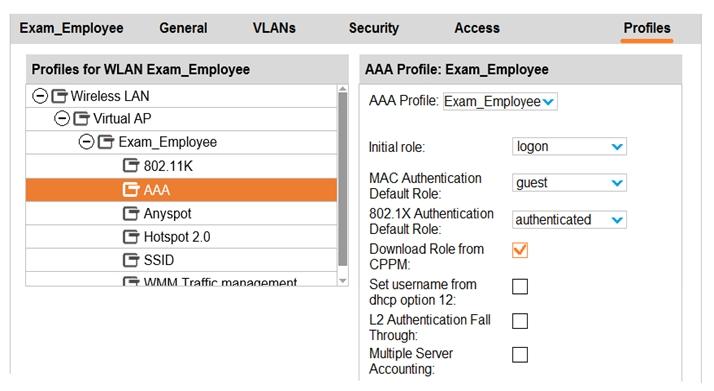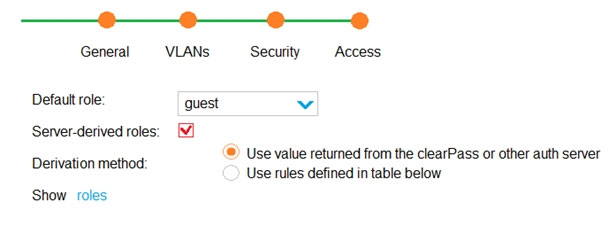Aruba Certified Mobility Associate Exam v1.0
Question 1
A company has an Aruba solution. The company wants to support a guest WLAN with the internal captive portal, but the company also wants to develop their own custom portal pages.
What correctly describes the level of customization that the internal captive portal supports?
- A. The internal captive portal must use the default pages without modification, but administrators can upload pages developed externally.
- B. The internal captive portal must use the default pages without modification, and administrators cannot upload pages developed externally.
- C. Administrators can modify the default internal captive portal pages, but cannot upload pages developed externally.
- D. Administrators can modify the default internal captive portal pages or upload pages developed externally.
Answer : D
Question 2
Refer to the exhibit.

Based on the exhibit, what is the maximum number of APs that this Mobility Master (MM) solution can support?
- A. 0
- B. 1
- C. 32
- D. 500
Answer : C
Question 3
What is a key difference between an Aruba Air Monitor (AM) and an Aruba Spectrum Analyzer (SA)?
- A. An AM detects threats such as rogue APs, while an SA analyzes RF conditions.
- B. An AM detects rogue APs and provides data services to clients, while an SA only detects rogue APs.
- C. An AM scans on only one 802.11 frequency band, while an SA scans on both 802.11 frequency bands.
- D. An AM both detects wireless intrusion attempts and mitigates them, while an SA only detects wireless intrusion attempts.
Answer : A
Question 4
For which use should network administrators set up Aruba access points (APs) as multi-zone APs?
- A. The company requires high availability for its wireless services, and APs must be able to be controlled by more than once Mobility Controller (MC) in case a controller fails.
- B. The company has multiple small offices where APs at each branch office must forward internet traffic locally and corporate traffic over a secure tunnel to a centralized Mobility Controller (MC).
- C. The company has some devices that support both 5GHz and 2.4 GHz, and the APs must operate in both frequency bands.
- D. The company has a Mobility Manager (MM)-based solution that requires APs to terminate to multiple controllers that reside in different administrative domains.
Answer : D
Question 5
Assume that administrators accept the default forwarding mode for WLANs. How does wireless user traffic flow in a master-local architecture, and how does it flow in a Mobility Master (MM) architecture?
- A. In the master-local architecture, traffic is tunneled to a local Mobility Controller (MC) to handle. In a MM architecture, all traffic is tunneled to the MM to handle.
- B. In the master-local architecture, all traffic is tunneled to the master controller to handle. In a MM architecture, all traffic is tunneled to the MM to handle.
- C. In both architectures, traffic is tunneled to a Mobility Controller (MC) to handle.
- D. In both architectures, APs forward corporate user traffic locally and tunnel guest user traffic to a Mobility Controller (MC) to handle.
Answer : C
Question 6
A WLAN in an Aruba Mobility Master (MM)-based solution uses WPA2-Enterprise security. This WLAN currently authenticates users to Active Directory (AD), and users log in with their Windows domain credentials. Network administrators now want to authenticate the Windows clients as well, based on the client Computer
Names.
What should the administrator do on MM to achieve this goal?
- A. Set up MAC Authentication on the WLAN.
- B. Set up Machine Authentication on the WLAN.
- C. Import the computer names from AD to the MM internal database.
- D. Bind individual Mobility Controllers (MCs) to AD at the device level.
Answer : B
Question 7
A company has an Aruba Mobility Master (MM)-based solution that runs ArubaOS 8 and uses the default AirMatch and Client Match settings. The ARM profile has been disabled for 5GHz radios.
How are channel and transmit power settings managed for these radios?
- A. with AirMatch
- B. with Rule Based Client Match
- C. with legacy ARM
- D. with legacy Client Match
Answer : A
Question 8
A customer has a large campus that requires 400 Aruba 335 APs to support a total of 10,000 wireless users and 12Gbps of traffic. Although the customer wants two controllers for redundancy, each controller must be able to support all of the APs and users on its own.
Which Aruba Mobility Controller models meet the customer requirements and DO NOT unnecessarily exceed them?
- A. Aruba 7030 controllers
- B. Aruba 7024 controllers
- C. Aruba 7240 controllers
- D. Aruba 7210 controllers
Answer : D
Question 9
Refer to the exhibit.

The exhibit shows the AAA profile for a WLAN on an Aruba solution. This WLAN uses 802.1X authenticate users to a RADIUS server. A user successfully authenticates with 802.1X, but the RADIUS server does not send a role assignment.
How does the Aruba firewall handle the role assignment for this user?
- A. It does not assign a role.
- B. It applies the Aruba VSA role, employee.
- C. It assigns the logon role.
- D. It assigns the authenticated role.
Answer : D
Question 10
A company currently uses Instant APs (IAPs), all managed by a virtual controller. The company expects to double in size within the next 18 months. The network manager wants to purchase additional APs to service the increased traffic load. The network manager also wants to deploy a Mobility Controller (MC) to manage all APs.
How should the network administrator adapt the current IAPs to a controlled architecture?
- A. Configure the IAPS to establish CPSec tunnels to the new MCs.
- B. Configure the IAPS to Campus APs, controlled by the new MCs.
- C. Manage both the MCs and IAP clusters with Aruba Central.
- D. Manage both the MCs and IAP clusters with a Mobility Master (MM).
Answer : B
Question 11
How does a high-gain omni-directional antenna compare to a typical omni-directional antenna?
- A. it provides more coverage in both the horizontal and vertical directions.
- B. it provides more single-user spatial streams.
- C. it provides more coverage in the horizontal direction than in the vertical direction.
- D. it provides more multi-user spatial streams.
Answer : C
Question 12
Which IEEE standard provides the highest transmission rates in the 2.4GHz frequency band?
- A. 802.11a
- B. 802.11ac
- C. 802.11g
- D. 802.11n
Answer : D
Question 13
A network administrator wants to assign an authentication server group to the WPA2-Enterprise WLAN. Which profile should the administrator modify?
- A. Virtual AP
- B. SSID
- C. AAA
- D. L2 Authentication
Answer : C
Question 14
What is one reason for a network administrator to visit the Dashboard > Usage window on an Aruba Mobility Master (MM)?
- A. to check license usage and determine the need for additional licenses
- B. to generate reports about traffic patterns and network usage over the past several months
- C. to view system usage statistics for the MM and troubleshoot potential issues
- D. to analyze short term trends in network usage by client, AP, and application
Answer : D
Question 15
Refer to the exhibit.

A network administrator sets up the Exam_Employees WLAN on an Aruba solution with a default role of guest, as shown in the exhibit. To which users does the guest role apply?
- A. users who have connected to the SSID, but have not yet attempted authentication
- B. users who successfully authenticate and are assigned to the default role by the RADIUS server
- C. users who successfully authenticate and are not assigned a different role by the RADIUS server
- D. users who fall authentication
Answer : C